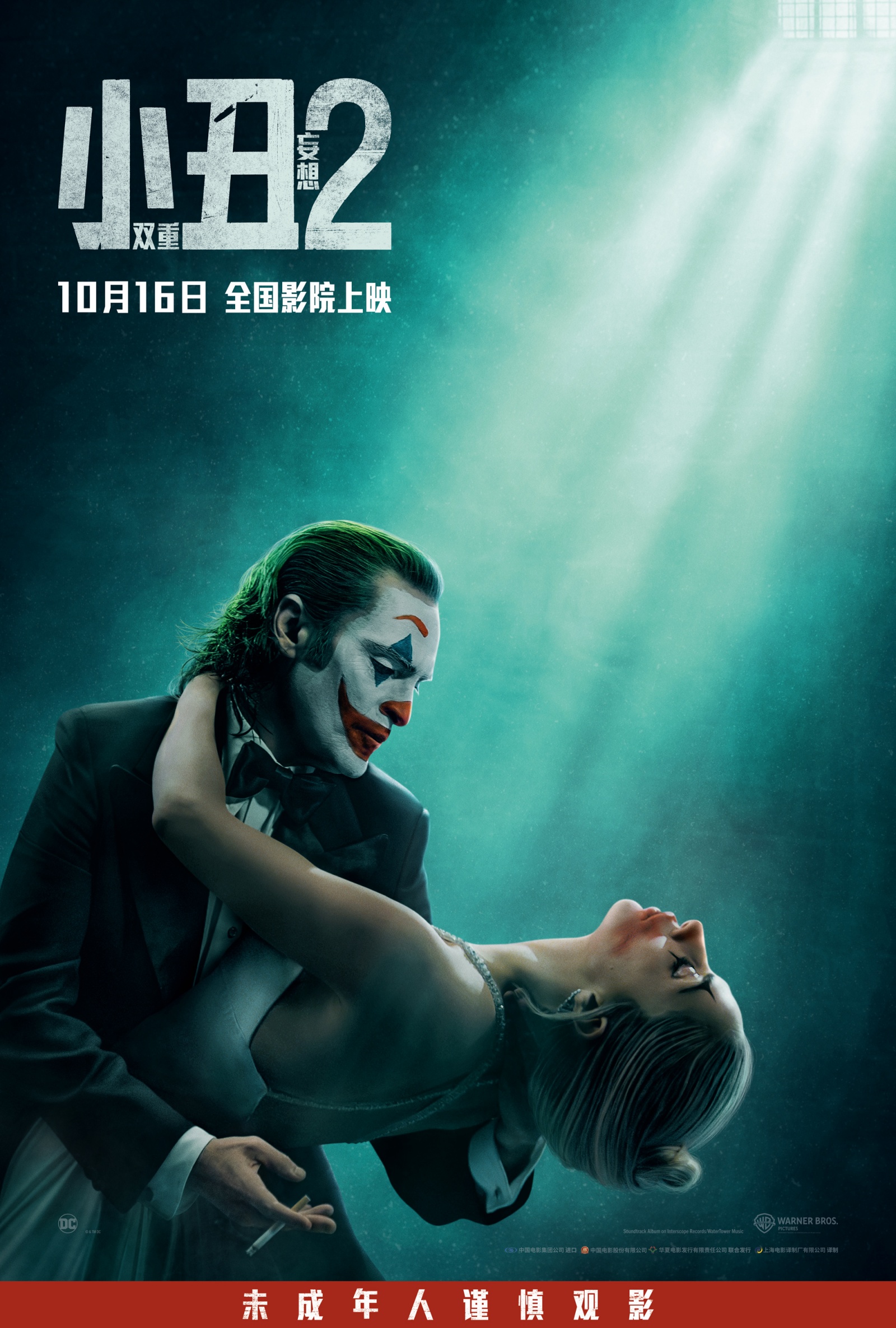
Five years ago, "Joker" was released under circumstances that didn't seem promising, yet it ultimately earned an impressive box office of $1.07 billion and surprisingly clinched the prestigious Golden Lion at the Venice Film Festival, making it a dark horse in the film industry. However, what no one anticipated was that its sequel, "Joker 2: Double Delusion," debuted in 4,100 theaters across North America with an opening box office of only $40 million, which is significantly lower than the first film's $96.2 million.
Reports indicate that foreign critics and audiences have overwhelmingly negative reviews, with a mere 33% freshness rating on Rotten Tomatoes. As the film was released in China in recent days, its ratings on Douban also appear disheartening compared to its predecessor. Is it true that "Joker 2: Double Delusion" is irredeemably “bad”?

Poster of "Joker 2: Double Delusion"
To be honest, I have personally experienced many of the flaws mentioned in reviews, such as "the narrative pace is too slow," "the story is thin and the atmosphere is dreary," and "it left me drowsy." I must admit, staying alert and engaged while watching the entire film is no easy feat; in other words, this film is indeed far from being "engaging" or "exciting."
However, to label this film as simply “bad” seems a bit unfair to director Todd Phillips. In the first film, the protagonist Arthur is a typical social outsider, neglected and uncared for, ultimately devolving into the "Joker," committing unforgivable crimes while justifiably questioning the existing social order. Following the typical Hollywood commercial film formula, the sequel would logically depict Arthur, now in prison, strengthening his empire with the newly introduced character, Harley Quinn, stirring up new chaos in Gotham City and further solidifying his classic "anti-hero" image.

Still from "Joker 2: Double Delusion"
But the reality is, none of that happens. If Arthur in the first film achieved a "comeback" through his identity as the "Joker," in this sequel, he is left with the impression of being "pathetic." Clearly, the director is determined to take his anti-hero, anti-conventional approach to the extreme and aims to completely subvert the character of the "Joker." It could be said that his creative ambition is substantial, showing no intention of following a well-trodden path.
This determination is epitomized in the seemingly minor character Gary. In the previous film, he was Arthur's only friend who understood him, and that’s why he survived the violence Arthur unleashed. Logically, he should steadfastly stand alongside Arthur. However, during the court proceedings, he completely disavows Arthur's actions, confessing that he feels utterly insignificant in the face of violence.

Still from "Joker 2: Double Delusion"
This reflects not just Gary's "survivor's guilt," but also reveals a deeper intention of the creators—stripping away the seductive facade to show that the "Joker" is neither a representative of the so-called lower class nor a champion of justice, but simply a coward who abuses violence.
During the final stages of the trial, the judge reminds Arthur that this is not a variety show or a comedy stage. Facing the cameras, Arthur seems to awaken, completely abandoning his "Joker" identity and beginning to confess his crimes. At this moment, he is no longer the mad, violent "Joker," but again reverts to his true self, the lonely, neglected, and pitiable man.
This is the source of the film's title's "delusion"—in the director's view, if a weak individual puts all their hope in a "Joker" who knows only violence and murder, it can neither improve their situation nor propel them to a place of irreparable despair.

Still from "Joker 2: Double Delusion"
Moreover, the other layer of “delusion” clearly pertains to Arthur's girlfriend, Harley. In this film, her "love at first sight" for Arthur is more an admiration for violence and crime than actual love. To her, who Arthur truly is matters little; fundamentally, she is no different from those who discriminate against and bully Arthur. What she desires is the antisocial, disorder-breaking "Joker," not the unlucky, pitiful, helpless Arthur.
This is why when Arthur acknowledges in court that it is not the "Joker," but himself who committed the crimes, Harley storms out in anger. When Arthur unexpectedly escapes the courtroom and reaches her side, she coldly abandons him once more, as her "delusion" has been utterly shattered.
The so-called “double delusion” symbolizes both the criminal Arthur's embellishment of his own crimes and the violent worshipper Harley's glorification of criminal acts. These two intertwined narratives undoubtedly reflect the director's profound commentary on the increasingly extreme and irrational state of the contemporary world.

Still from "Joker 2: Double Delusion"
Notably, the film is filled with cameras and recording devices. They represent the contemporary media landscape we inhabit. In the previous film, the "Joker" was born from a live variety show; in this sequel, Arthur's trial is also broadcast live. One could say, the image of the "Joker" is inherently shaped by modern media. The victim of this "cult of personality" is every ordinary person, and the unexpected explosion in the courtroom serves as a metaphor: modern media glorifies the "Joker," directly producing wave after wave of "new Jokers" who are destroying the world we live in.
Is this not another form of "delusion" for modern individuals? We believe we can witness the truth through the lens, but that may merely be a distorted and fabricated "narrative." In this light, "Joker 2: Double Delusion" is certainly not a “throwaway” work by the director. On the contrary, it truly embodies the concept of the "anti-hero," demonstrating to the audience that Arthur is simply Arthur, and the "Joker" is merely the audience's "delusion.”
However, the most critical issue with this film lies precisely here. If Arthur in the previous film embodied a radical mindset, this film completely devolves into a representative of conservatism, wholly negating the “Joker's” critique of unjust social systems and the exposure of the cold, selfish traits of modern humanity. Is this not contradictory, a self-defeating stance? The dual failures in reputation and box office have vividly illustrated that audiences did not buy into this.

On Douban, some users made a pun—Gotham becomes "Song Field"
The thematic confusion has already become problematic, and the director has even inserted numerous song and dance numbers into the film, frequently interrupting the already uneven narrative flow and showing very clear signs of being unnecessarily padded. Just because the lead star is Lady Gaga, does she have to sing? It’s worth noting that the dance on the stairs in the previous film became a classic scene because it was built up by preceding plot developments, but in this film, the clumsy dance scenes are reminiscent of Bollywood.
Most regrettably, the classic image of the "Joker" has been squandered. If he ultimately is just a cowardly, selfish, incompetent criminal, then the creators had no reason to borrow this IP from the DC universe. Like Batman, he is also a legendary figure of Gotham, an important symbol of rebellion against the world, and all of this has been ruthlessly trampled and discarded by the director. Higher expectations have led to greater disappointment. Since the director clearly looks down on the "Joker," letting him wallow for two hours in this film is less satisfying than allowing him to die pitifully in his apartment in the first film.
However, after watching this film, as I left the theater and reflected on that brutal, cold ending, I finally understood the director’s heartfelt intent: after all this, the "Joker" is actually myself, and all the viewers who loved the first film.

Still from "Joker 2: Double Delusion"


